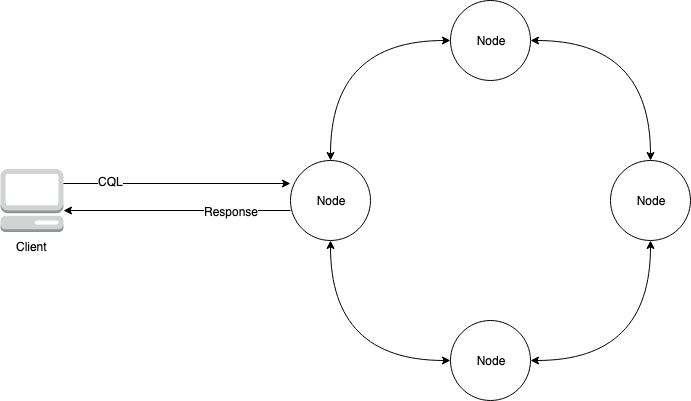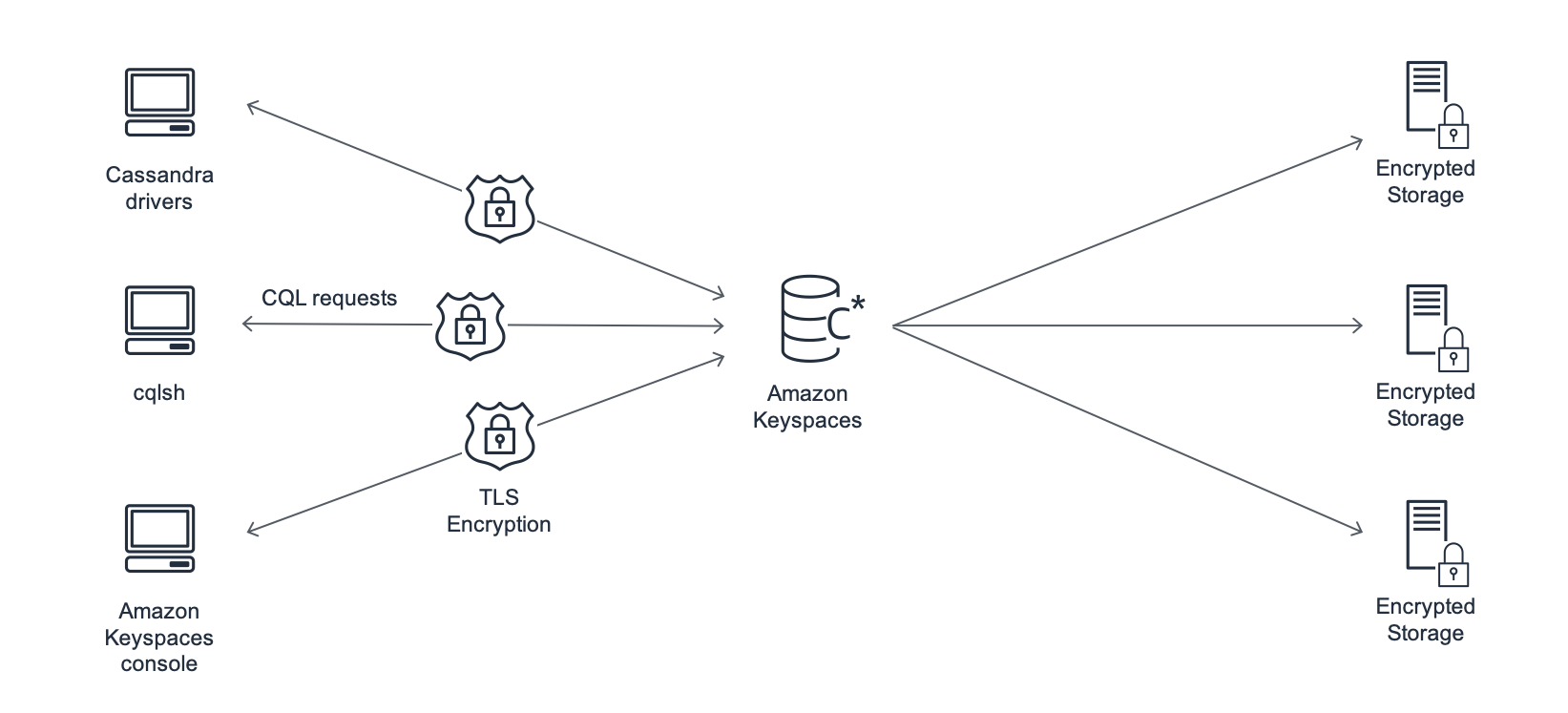Amazon Keyspaces removes the administrative overhead of managing Cassandra. To understand why, it's helpful to begin with Cassandra architecture and then compare it to Amazon Keyspaces.
Topics
High-level architecture: Apache Cassandra
vs. Amazon Keyspaces
Traditional Apache Cassandra is deployed in a cluster made up of one or more nodes. You are responsible for managing each node and adding and removing nodes as your cluster scales.
A client program accesses Cassandra by connecting to one of the nodes and issuing Cassandra Query Language (CQL) statements. CQL is similar to SQL, the popular language used in relational databases. Even though Cassandra is not a relational database, CQL provides a familiar interface for querying and manipulating data in Cassandra.
The following diagram shows a simple Apache Cassandra cluster, consisting of four nodes.

A production Cassandra deployment might consist of hundreds of nodes, running on hundreds of physical computers across one or more physical data centers. This can cause an operational burden for application developers who need to provision, patch, and manage servers in addition to installing, maintaining, and operating software.
With Amazon Keyspaces (for Apache Cassandra), you don’t need to provision, patch, or manage servers, so you can focus on building better applications. Amazon Keyspaces offers two throughput capacity modes for reads and writes: on-demand and provisioned. You can choose your table’s throughput capacity mode to optimize the price of reads and writes based on the predictability and variability of your workload.
With on-demand mode, you pay for only the reads and writes that your application actually performs. You do not need to specify your table’s throughput capacity in advance. Amazon Keyspaces accommodates your application traffic almost instantly as it ramps up or down, making it a good option for applications with unpredictable traffic.
Provisioned capacity mode helps you optimize the price of throughput if you have predictable application traffic and can forecast your table’s capacity requirements in advance. With provisioned capacity mode, you specify the number of reads and writes per second that you expect your application to perform. You can increase and decrease the provisioned capacity for your table automatically by enabling automatic scaling.
You can change the capacity mode of your table once per day as you learn more about your workload’s traffic patterns, or if you expect to have a large burst in traffic, such as from a major event that you anticipate will drive a lot of table traffic. For more information about read and write capacity provisioning, see Configure read/write capacity modes in Amazon Keyspaces.
Amazon Keyspaces (for Apache Cassandra) stores three copies of your data in multiple
Availability
Zones
The following diagram shows the architecture of Amazon Keyspaces.

A client program accesses Amazon Keyspaces by connecting to a predetermined endpoint (hostname and port number) and issuing CQL statements. For a list of available endpoints, see Service endpoints for Amazon Keyspaces.
Cassandra data model
How you model your data for your business case is critical to achieving optimal performance from Amazon Keyspaces. A poor data model can significantly degrade performance.
Even though CQL looks similar to SQL, the backends of Cassandra and relational databases are very different and must be approached differently. The following are some of the more significant issues to consider:
- Storage
-
You can visualize your Cassandra data in tables, with each row representing a record and each column a field within that record.
- Table design: Query first
-
There are no
JOINs in CQL. Therefore, you should design your tables with the shape of your data and how you need to access it for your business use cases. This might result in de-normalization with duplicated data. You should design each of your tables specifically for a particular access pattern. - Partitions
-
Your data is stored in partitions on disk. The number of partitions your data is stored in and how it is distributed across the partitions is determined by your partition key. How you define your partition key can have a significant impact upon the performance of your queries. For best practices, see How to use partition keys effectively in Amazon Keyspaces.
- Primary key
-
In Cassandra, data is stored as a key-value pair. Every Cassandra table must have a primary key, which is the unique key to each row in the table. The primary key is the composite of a required partition key and optional clustering columns. The data that comprises the primary key must be unique across all records in a table.
-
Partition key – The partition key portion of the primary key is required and determines which partition of your cluster the data is stored in. The partition key can be a single column, or it can be a compound value composed of two or more columns. You would use a compound partition key if a single column partition key would result in a single partition or a very few partitions having most of the data and thus bearing the majority of the disk I/O operations.
-
Clustering column – The optional clustering column portion of your primary key determines how the data is clustered and sorted within each partition. If you include a clustering column in your primary key, the clustering column can have one or more columns. If there are multiple columns in the clustering column, the sorting order is determined by the order that the columns are listed in the clustering column, from left to right.
-
For more information about NoSQL design and Amazon Keyspaces, see Key differences and design principles of NoSQL design. For more information about Amazon Keyspaces and data modeling, see Data modeling best practices: recommendations for designing data models.
Accessing Amazon Keyspaces from an
application
Amazon Keyspaces (for Apache Cassandra) implements the Apache Cassandra Query Language (CQL) API, so you can use
CQL and Cassandra drivers that you already use. Updating your application is as easy as
updating your Cassandra driver or cqlsh configuration to point to the Amazon Keyspaces
service endpoint. For more information about the required credentials, see Create and configure AWS credentials for Amazon Keyspaces.
Note
To help you get started, you can find end-to-end code samples of connecting to Amazon Keyspaces by using various Cassandra client drivers in the
Amazon Keyspaces code example repository on GitHub
Consider the following Python program, which connects to a Cassandra cluster and queries a table.
from cassandra.cluster import Cluster
#TLS/SSL configuration goes here
ksp = 'MyKeyspace'
tbl = 'WeatherData'
cluster = Cluster(['NNN.NNN.NNN.NNN'], port=NNNN)
session = cluster.connect(ksp)
session.execute('USE ' + ksp)
rows = session.execute('SELECT * FROM ' + tbl)
for row in rows:
print(row)To run the same program against Amazon Keyspaces, you need to:
-
Add the cluster endpoint and port: For example, the host can be replaced with a service endpoint, such as
cassandra.us-east-2.amazonaws.comand the port number with:9142. -
Add the TLS/SSL configuration: For more information on adding the TLS/SSL configuration to connect to Amazon Keyspaces by using a Cassandra client Python driver, see Using a Cassandra Python client driver to access Amazon Keyspaces programmatically.